Introduction
Pop art is a visual art movement flourished at the dawn of 1950s. Pop art is a shortened term for “popular art” which were taken from mass culture; this movement surfaced as a reaction against the seriousness of abstract expressionism.
Beer bottles, soup cans, comic strips, road signs, and similar objects in paintings, collages, and sculptures are the main subject of pop art. Most commonly used materials are plastic, urethane foam, and acrylic paint. The images are presented in strange and bizarre combinations, distortions, or exaggerations of size. The original human-made object is always kept in its true form in some way. Pop art had its tremendous impact in advertising, graphic, and fashion design through mass media.
Pop art depicts the details of everyday life in which people derive most of their visual language in what they perceive to be the real world of entertainment, leisure, and media advertisements. Lawrence Alloway pioneered the use of the term “pop art”. He is known to be one of the eminent critics of the art during his time; he describes those paintings that celebrated post-war consumerism and challenge the psychology of Abstract Expressionism.
Pop art attracts American artists living in-between industrial and commercial environment producing an audacious exhibit of art and advertising. While many artists duplicated beer bottles, soup cans, and comic strips in their artworks, other artists incorporated these objects in their actual artworks. In both cases of artworks, however, pop artists stressed “new” and “store-bought” in a shocking light, symbolizing their interpretations of the changes that took place in America during that time. Their vulgar interpretations, which appeared in advertising, supermarkets, and television, explains why the pop art movement had such a large impact on commercial, graphic, and fashion design (Russell, 54).
All through pop art’s popularity, a series of crucial events marked the history, a few to mention are the assassination of John F. Kennedy, racial riots breaking out in cities everywhere, and addictions to sex, drugs, and rock ‘n’ roll.
Pop art serves as an avenue of time’s splendid dreams, traumas, extravagance, and scarcity. It opens the perception that there is a dire need to support the advertising realm.
Ideal and thinking of pop art
Andy Warhol, often recognized as the father of pop art, primarily acquaints the public of his own interpretation of the Campbell’s soup can. He perceived Campbell’s soup can as one fascinating object of art. This clearly shows that an advertisement is not just an eye-catching work of art but a main object in the world of commerce.
Warhol’s 100 Cans beats a repetitive visual tattoo whose power derives from the insistence of similar commercial imagery in the daily lives of the public (Ocvirk, 305).
Boldness and acquisitiveness of modern mass culture is depicted in the images which add vibrant in the products of pop art than that of the realistic paintings of the past.
Pop artists encourage viewer to be a more responsible observer that allows them to criticize the object rather than focus to the skill and personality of the artist.
However there are some that uses their wit in criticizing, but there are also who uses it as an object of mockery and ridicule.
When, how did it started?
Shortly after 1950s, independent of the British group, American artists Robert Rauschenberg and Jasper Johns began to explore issues of mass culture in their art. Both artists responded against avoiding subject matter and the conceptual seriousness of abstract expressionist painting.
The pop art movement reached its height in the 1960s. Pop art grabs its subjects from mass media: advertising, comic books, or televised news programs. American pop artists of the 1960s were accustomed to materials and techniques that were motivated by commercial processes and their works look more mechanical, with little brushwork or other signs of artistic expression.
Andy Warhol known for his images of pop icons such as Marilyn Monroe and Elvis Presley often made silkscreen prints, a technique also used for printing T-shirts. Roy Lichtenstein imitated not only the subject matter, but also the printing technique of comic books, but on a much larger scale, so that the colored dots of the printing process are evident.
What changed after?
A new perception of pop art emerges as images of women are more visible portraying these images in a more sensual and seductive way of attracting viewers; which was also the trend of the past societies in depicting women, or the way they intend to visualize them. This style is evident in Warhol’s artwork. His series of Marilyns became not surprisingly popular after her death in 1962. The Twenty-Five Marilyns is a perfect representation of this new representational style of women.
Changes were influenced by later artists like Tom Wesselmann and Allen Jones who presented their subjects in a more shocking and awful perspective. During the mid-1960s, Allen Jones was notorious for outraging feminists, depicting women in scenes of bondage and subjugation (Packer). This portrayal astonished the public’s eye because in the past art styles, women’s bodies were often positioned to attract male viewers.
Women’s bodies were often the target of graphic manipulation. This sexual presentation was seen as pleasurable entertainment for male viewers, as much past artwork often did.
American pop artists
Known to be the “fathers of Pop Art” are Robert Rauschenberg and Jasper Johns, both were influenced by John Cage, who, of course, was heavily influenced by Marcel Duchamp.
Robert Rauschenberg and Jasper Johns offered the initial impulsion—Rauschenberg with his collages constructed from household objects such as quilts and pillows, Johns with his series of paintings depicting American flags and bull’s-eye targets. The first full-fledged pop work was Just What Is It That Makes Today’s Home So Different, So Appealing? (1956, private collection) by the British artist Richard Hamilton. In this satiric collage of two ludicrous figures in a living room, the pop hallmarks of exuberance, incongruity, crudeness, and good humor are emphasized.
In 1960 Johns finished his painted cast bronzes of Ballantine beer cans. After a year, Claes Oldenburg constructed the first of his dazzling, humorous plastic sculptures of hamburgers and other fast-food items; during that time Roy Lichtenstein widen the range of pop art with his oil paintings that mimic blown-up frames of comic strips. Several pop artists also produced happenings or theatrical events staged as art objects.
Pop art applied the method of mass production. Rauschenberg and Johns had already discarded individual, titled paintings in favor of large series of works, all depicting the same objects. In the early 1960s the American Andy Warhol carried the idea a step further by adopting the mass-production technique of silk-screening, turning out hundreds of identical prints of Coca-Cola bottles, Campbell’s soup cans, and other familiar subjects, including identical three dimensional Brillo boxes.
White plaster casts of real people in real settings, by George Segal; pastries depicted in thick paint that resembles cake frosting, by Wayne Thiebaud; paintings imitating billboards, by James Rosenquist; the satiric Great American Nudes series of Tom Wesselmann; objects combined with painting, by Jim Dine; and designs of words, numbers and symbols, by Robert Indiana are some of the important products of pop arts.
Other major American Pop artists are Richard Artschwager, Jim Dine, Red Grooms, Robert Indiana, Ray Johnson, Edward Kienholz, Roy Lichtenstein, Marisol, Claes Oldenburg, Mel Ramos, Larry Rivers, James Rosenquist, Edward Ruscha, George Segal, Wayne Thiebaud, Andy Warhol, and Tom Wesselmann.
Famous works
Famous arts transpired from the works of Robert Rauschenberg and, Jasper Johns, which is characterized by an interest in ordinary objects, irony, and a faith in the effectiveness of images. American Pop Art flourished specifically in New York, where at the outset artists such as Claes Oldenburg and Jim Dine, Roy Lichtenstein and Andy Warhol exhibited then James Rosenquist, George Segal and Tom Wesselmann.
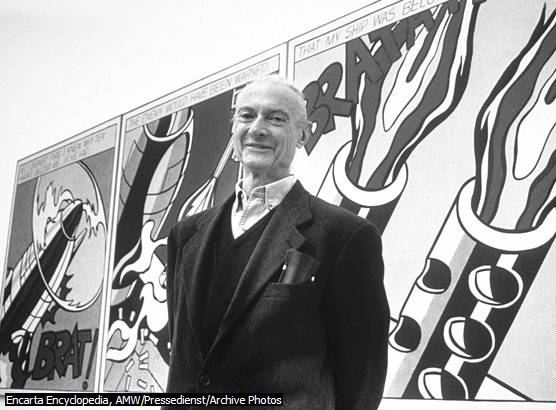
A major figure of the 1960s pop art movement, Roy Lichtenstein painted large-scale works that were often styled after comic-book illustrations. His paintings offer a playful commentary on the relationship between the artistic discipline of traditional painting and the mass-produced commercialism of popular culture.
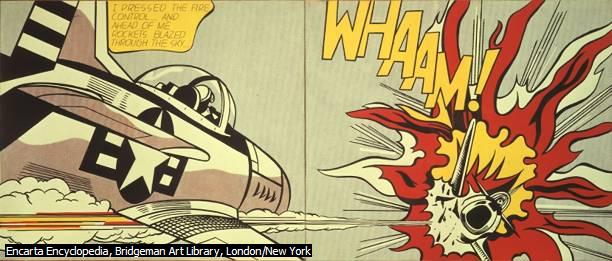
American painter, sculptor, and graphic artist Roy Lichtenstein was painted in 1963. It is acrylic on canvas. Lichtenstein was one of the first artists to develop a style known as pop, in which images from advertising and comic books became the subject matter of serious art. This painting is part of the collection at the Tate Gallery, London.
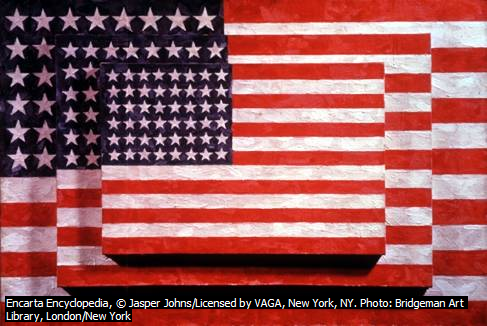
American artist Jasper Johns is one of a series of flag paintings by the artist, who is considered one of the forerunners of pop art. In this piece Johns painted three separate oil paintings of flags and attached them to each other, creating a three-dimensional object.
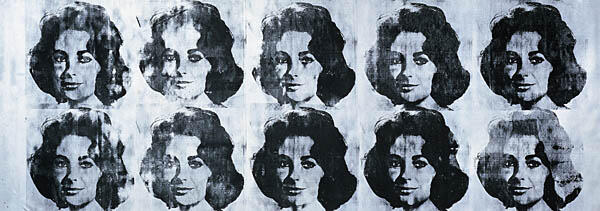
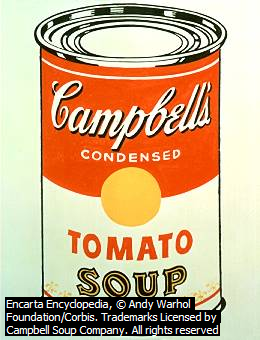
Andy Warhol is one of a number of virtually identical paintings done by the artist in the early 1960s. The cartoon like image, flat and simplified, is characteristic of pop art. Warhol selected his subject matter from amongst images already present in popular culture or advertising, thereby keeping his work intentionally impersonal.
References
- Concise Columbia Electronic Encyclopedia. Pop art. 1994. Web.
- Ocvirk, Otto G., et al. Art Fundamentals: Theory and Practice. Boston: McGraw Hill, 1998.
- Packer, William. “Tragi-comic Battle of the Sexes.” London: Financial Times, 1999.
- Perry, Gill. Gender and Art. Yale University Press, 1999. 229-239
- “Pop Art.” Microsoft® Encarta® 2007 [DVD]. Redmond, WA: Microsoft Corporation, 2006.
- Barnes, Bernadine. “Questions and Answers About Art”. Wake Forest University, Winston-Salem, North Carolina. Microsoft ® Encarta ® 2007. © 1993-2006 Microsoft Corporation. All rights reserved.
- Warhol, Andy. “Ten Lizes”. 1963. Adagp, Paris 2007.